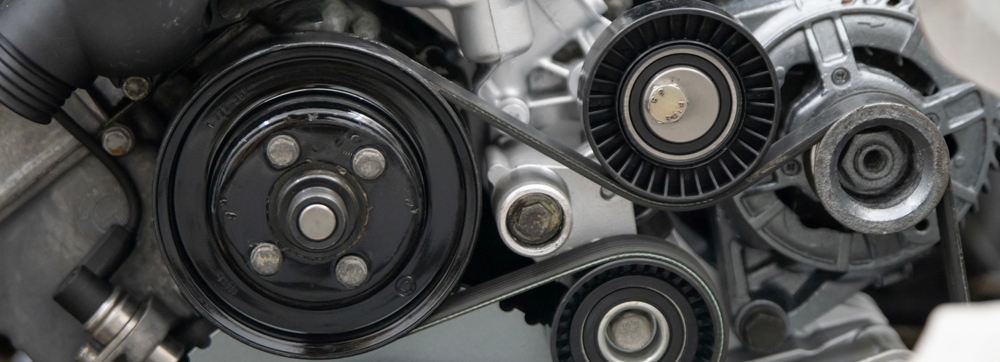 Automotive parts and jargon can be confusing at times. Let’s take drive belts, for example. Some people still use terms like ‘fan belt’ when they actually mean either a serpentine belt or a V-belt. This blog will highlight the facts & differences between drive belts and when to schedule an auto repair appointment for a bad serpentine belt or timing belt.
Automotive parts and jargon can be confusing at times. Let’s take drive belts, for example. Some people still use terms like ‘fan belt’ when they actually mean either a serpentine belt or a V-belt. This blog will highlight the facts & differences between drive belts and when to schedule an auto repair appointment for a bad serpentine belt or timing belt.
What Is A Serpentine Belt?
The serpentine belt harnesses energy from a combustion engine and transfers it to power other systems. Newer engine designs utilize a single, long drive belt (called a serpentine belt) to run all of the vehicle’s electronic accessories. Older engine designs use multiple drive belts (called V-belts) to operate electronic accessories individually. Back in the day, car owners often referred to V-belts as a ‘fan belt’ or ‘alternator belt’ because of the duty that specific belt performed. Whether your car is old or new, these drive belts supply power to components such as:
- Air Conditioning Compressor
- Alternator
- Cooling Fan
- Power Steering Pump
- Water Pump
How Do They Work?
Serpentine belts are very durable, made from reinforced materials, including EPDM. They are very long, flat, and thin, featuring vertical grooves on one side. A single serpentine belt connects to each individual component via a pulley and maintains the correct tension via a belt tensioner. Serpentine belts run all your vehicle’s systems at the same time with a single, continuous belt and several pulleys.
V-Belts utilize a combination of synthetic and natural rubber compounds, with various internal tensile cords formed into a uniform trapezoidal shape. The outer surface offers high-friction wear resistance, minimizing belt slippage and extending belt life. The inner core provides shock absorption, strength, and thermal stability under the high temperatures produced by your vehicle’s engine. V-belts usually operate a single component, so there are several V-belts running different systems simultaneously..
You can see the serpentine belt (or numerous V-belts) on the outside of your vehicle’s engine block.
How Are They Different From Timing Belts?
Serpentine belts supply power to numerous components simultaneously. Essentially, this one belt runs multiple systems at the same time, whereas timing belts perform a single function.
What Is A Timing Belt?
The timing belt synchronizes the movements of the camshaft and crankshaft. Basically, it allows the crankshaft to turn the camshaft through intake, compression, power, and exhaust strokes without striking the pistons.
How Do They Work?
The timing belt consists of durable materials (welded urethane, neoprene, or molded polyurethane) that form horizontal teeth on one side. The timing belt helps the camshaft open and close the intake and exhaust valves at the correct times, preventing the piston from hitting them. In some internal combustion engines, the timing belt can also run the engine’s oil pump and water pump. You can find your timing belt inside your vehicle’s engine.
How Are They Different From A Serpentine Belt?
For the most part, timing belts perform a single function – they keep your engine operating in sync. If your timing belt doesn’t function properly, the valves can stay open and collide with the piston. In this scenario, a faulty timing belt can cause extensive damage to your engine, requiring expensive auto repairs. Alternatively, serpentine belts often operate numerous systems simultaneously.
Symptoms Of Failing Drive Belts
Serpentine Belt
You now know that the serpentine belt runs multiple systems in your vehicle. The symptoms of a loose, worn, or failing serpentine belt can include:
- Dashboard Warning Lights – usually more than one (ie, Battery, Temperature Gauge, Fluid Levels).
- Malfunctioning Air Conditioning – Warm air blowing from the vents may be an issue with the drive belt. Your service technician can determine if a bad drive belt is causing your air conditioning to malfunction.
- Overheating Engine – The serpentine belt operates the water pump, so an overheating engine may indicate a failing belt.
- Power Steering Loss – one of the first signs of a failing serpentine belt is a loss of power steering. If it becomes harder to steer or turn the steering wheel, schedule a service to inspect the serpentine belt.
- Squealing Noise – A high-pitched squeal or chirp under the hood (while the engine is running) can indicate a worn, misaligned, or slipping serpentine belt. Schedule a diagnostic inspection to determine if your vehicle requires a new belt.
Timing Belt
If your car shows any of the following symptoms, make an appointment for service as soon as possible:
- Check Engine Light – A bad timing belt may trigger your Check Engine Light.
- Engine Won’t Turn Over – Hard starts, rough idle, and misfires may be due to a failing timing belt.
- Smoke – After starting the car, smoke may billow from the engine compartment if your timing belt is worn or broken.
- Oil Leaks – There can be many reasons why your engine leaks oil, so schedule a diagnostic service appointment with your auto service center to determine the cause.
Fun Facts About Drive Belts
- Electric vehicles (EVs) use an electric power source instead of an internal combustion engine (ICE), so they don’t use drive belts to power auxiliary systems.
- Some automotive manufacturers (ie, BMW) use a timing chain instead of a drive belt on a few of their car models.
- Timing belts often last 60,000 – 100,000 miles before requiring replacement.
- Serpentine belts routinely last 90,000-100,000 miles before requiring replacement.
Drive Belts & Auto Repair in Kirkland, WA
Fisher’s Auto Service is here to help you with all your auto repair needs. If you suspect your vehicle has an issue with a serpentine belt or timing belt, our certified technicians will provide a thorough inspection. We carry replacement drive belts for most domestic and imported vehicles.
Schedule A Serpentine Belt or Timing Belt Service
Contact us at (425) 823-4441 for all your auto repair, diagnostic, and preventive maintenance needs. You can also visit our website to schedule an appointment. We look forward to hearing from you!

